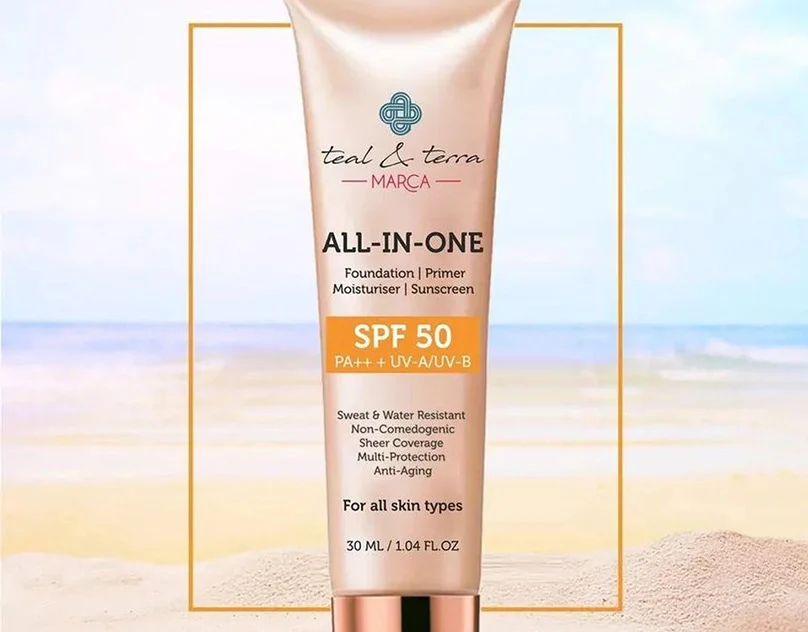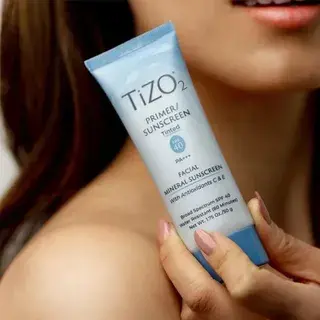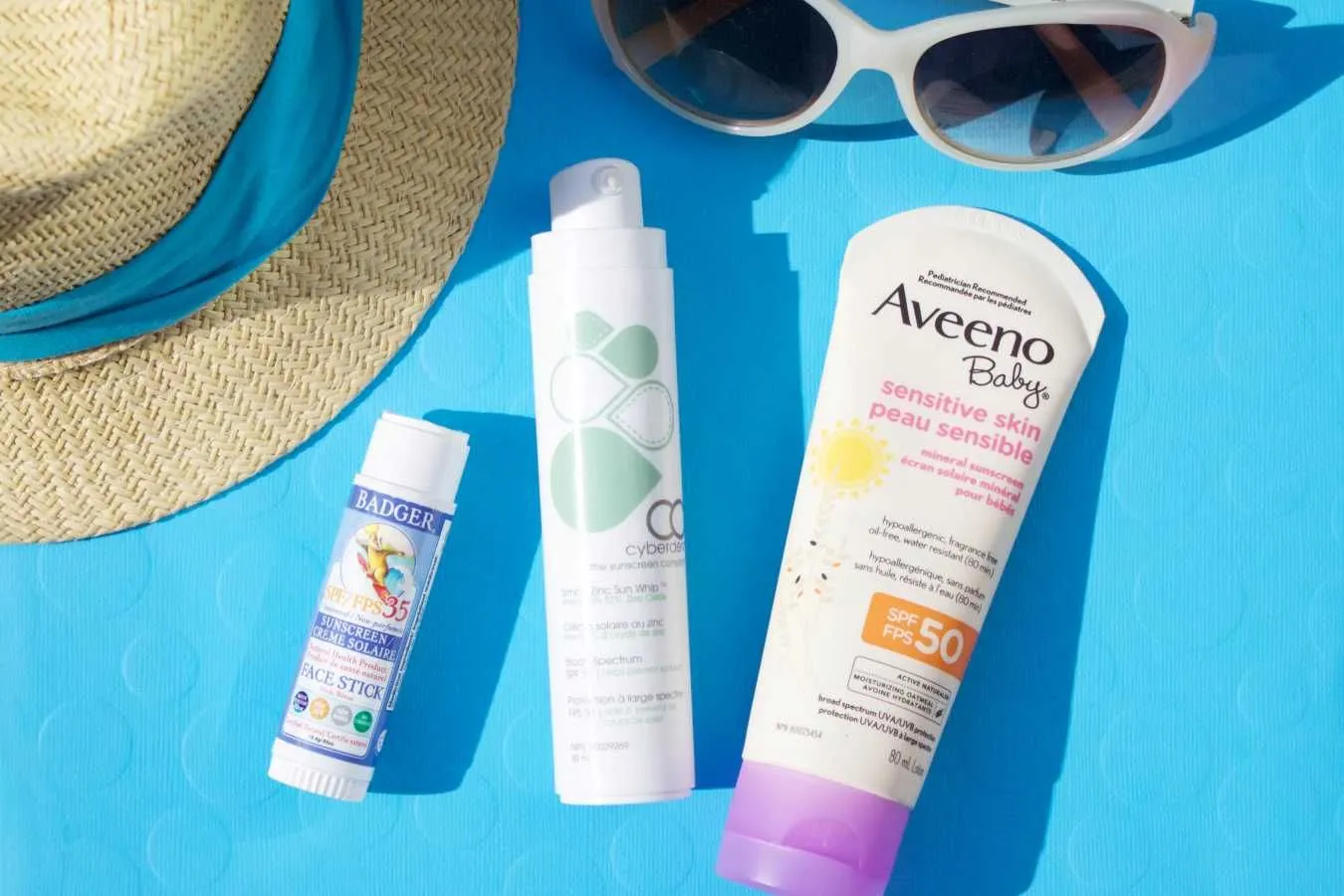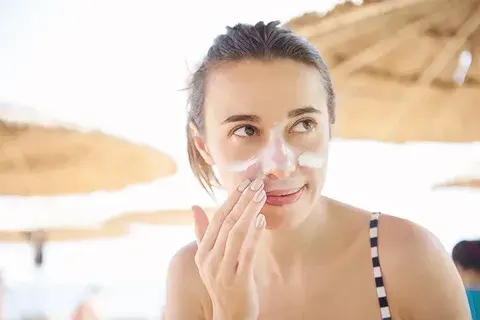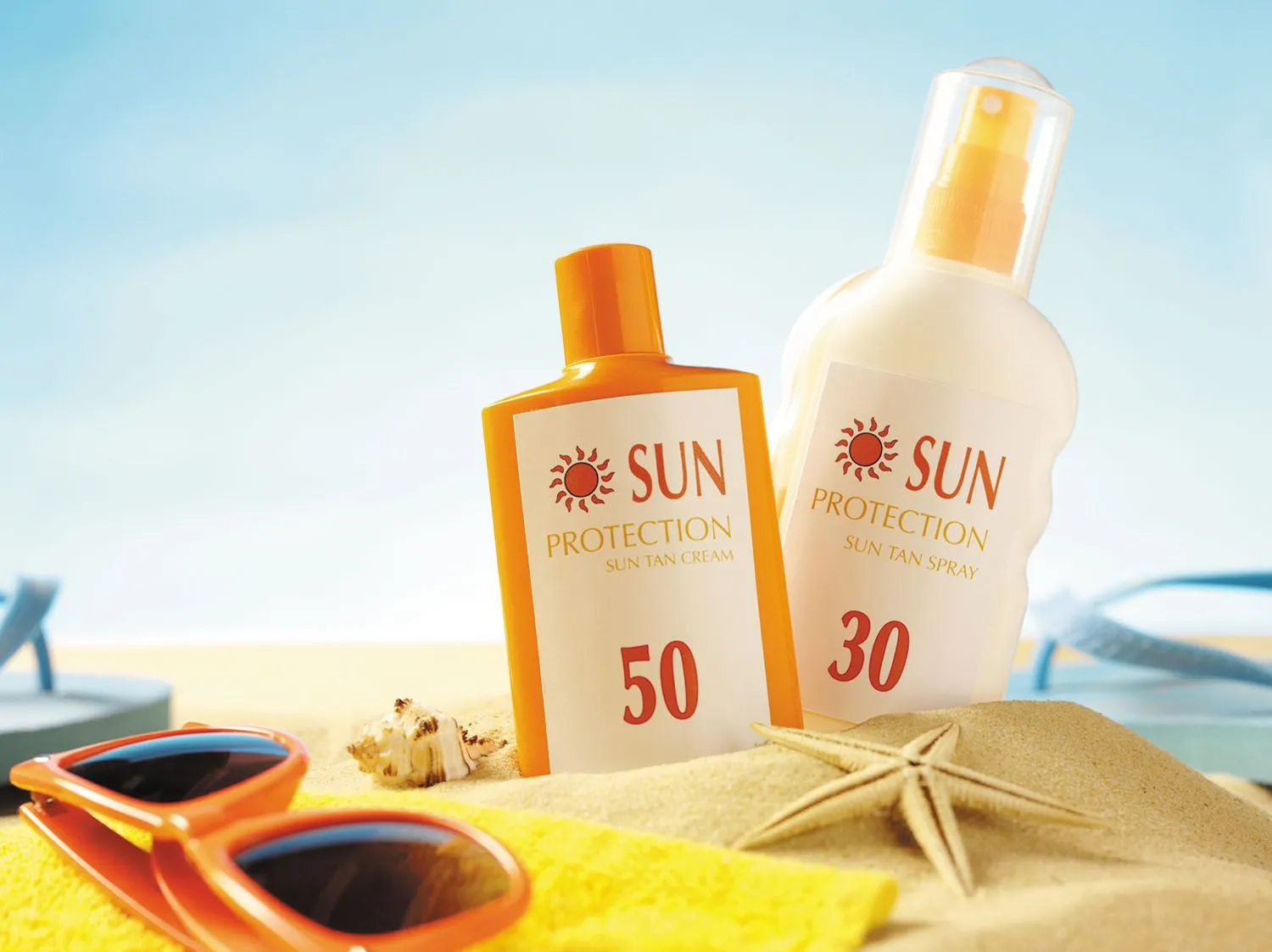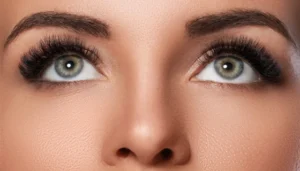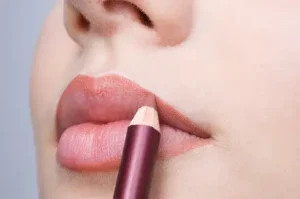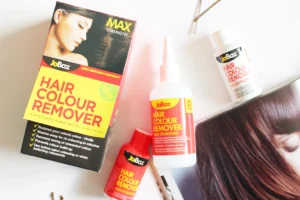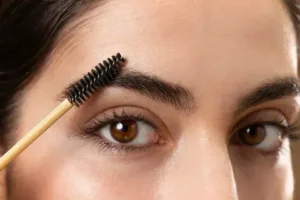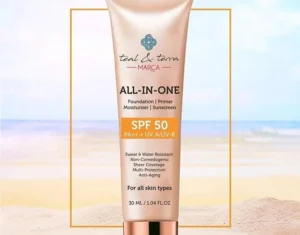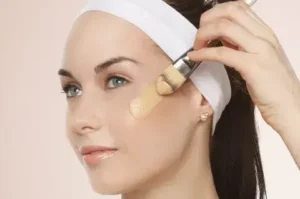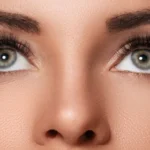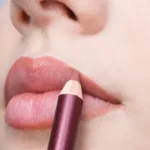While both sunscreen and primer play a crucial role in our skincare and makeup routines, they serve distinct purposes.
Sunscreen’s primary function is to protect the skin from harmful UV rays, shielding it from the damaging effects of sun exposure.
This is a vital step in any skincare regimen, as excessive sun exposure can lead to premature aging, dark spots, and even an increased risk of skin cancer.
On the other hand, primers are designed to create a smooth, even canvas for makeup application, helping it adhere better and last longer throughout the day.
Primers work by filling in fine lines and pores, blurring imperfections, and creating a seamless base for your foundation, concealer, and other cosmetics.
Sunscreen Formulations: Typical sunscreen formulas contain active ingredients like zinc oxide, titanium dioxide, or chemical UV filters that absorb or reflect UV radiation.
These formulas often have a thicker, more emollient texture to ensure adequate coverage and protection.
Sunscreens come in a variety of forms, including lotions, creams, gels, and even powders, allowing you to find the right texture and finish for your skin type and preferences.
Primer Formulations: Primers, on the other hand, generally have a lighter, silicone-based texture that helps fill in fine lines and pores, creating a smoother, more uniform surface for makeup.
They may also contain blurring agents or pigments to subtly color-correct the skin, as well as ingredients like vitamins, antioxidants, and hydrating agents to nourish and prime the skin.
The key difference lies in how these products interact with and impact makeup applications.
Sunscreens can sometimes interfere with the smooth layering of makeup, potentially causing pilling or separation, while primers are formulated to work seamlessly with cosmetics, enhancing their wear and longevity.
The Pros of Using Sunscreen as Primer
While using sunscreen as a primer may not be the optimal solution, there are a few potential benefits to this approach:
- Sun Protection: By using sunscreen as a primer, you can simultaneously protect your skin from harmful UV rays while prepping it for makeup application. This is especially beneficial for those who spend a lot of time outdoors or live in sunny climates, as it helps ensure your skin is shielded from sun damage throughout the day.
- Time and Cost Savings: Eliminating the need for a separate primer can save you time in your routine and potentially some money, as you won’t have to purchase an additional product. This can be particularly appealing for those with busy schedules or who are looking to streamline their skincare and makeup regimens.
- Smoother Makeup Application: Depending on the sunscreen formula, it may provide a smooth, even base that can help your makeup glide on more seamlessly. Some sunscreens with a more silicone-like texture can mimic the blurring and smoothing effects of a traditional primer, resulting in a more flawless makeup application.
- Potential Skin Benefits: Certain sunscreen formulas may contain additional skin-nourishing ingredients, such as antioxidants or moisturizing agents, which could provide added benefits for the skin beyond just sun protection. This can be a bonus for those looking to multitask and get the most out of their products.
The Cons of Using Sunscreen as Primer
However, there are also some drawbacks to consider when using sunscreen as a makeup primer:
- Lack of Priming Benefits: Sunscreens are not designed to offer the same blurring, gripping, and long-lasting effects as dedicated makeup primers. They may not provide the same level of pore-filling and smoothing benefits that primer formulas are specifically engineered to deliver.
- Compatibility Issues: Certain sunscreen and makeup formulas may not be compatible, leading to issues like pilling, separation, or disrupted wear. The thicker, more emollient texture of some sunscreens can interfere with the application and adherence of makeup, causing it to break down or appear uneven.
- Reduced Makeup Longevity: The emollient nature of some sunscreens could interfere with the longevity and staying power of your makeup, causing it to break down more quickly throughout the day. This can be especially problematic for those with oily or combination skin types, who may find that their makeup doesn’t last as long when using a sunscreen as a primer.
- Potential for Clogged Pores: Certain sunscreen formulas, particularly those that are thick or heavily occlusive, may be more prone to clogging pores and contributing to breakouts. This can be a concern for individuals with acne-prone or sensitive skin.
- Limited Primer-Specific Benefits: Sunscreens do not offer the same color-correcting, blurring, or smoothing benefits that dedicated primer formulas are designed to provide. This means that you may not achieve the same flawless, poreless-looking finish that you would with a primer specifically tailored for makeup application.
Guidelines for Using Sunscreen as Primer
If you do decide to use sunscreen as a primer, there are a few guidelines to keep in mind to help ensure the best possible results:
- Ensure Compatibility: Before attempting to use a sunscreen as a primer, do a patch test to ensure the formulas are compatible and work well together. This will help you avoid any unwanted pilling, separation, or other issues that could disrupt your makeup application. Pay close attention to the texture, finish, and ingredient lists of both the sunscreen and your preferred makeup products.
- Apply Properly: When using sunscreen as a primer, be sure to apply it in a thin, even layer and allow it to fully absorb before applying your makeup. This can help create a smoother, more seamless base that doesn’t interfere with the layering of your cosmetics. Avoid applying the sunscreen too thickly, as this can potentially lead to pilling or a greasy, heavy-feeling finish.
- Prioritize Skin Protection: Remember that the primary purpose of sunscreen is to protect your skin from harmful UV rays. So, be sure to apply a sufficient amount to achieve the necessary level of sun protection, even if you’re using it as a primer. Skimping on the sunscreen application could compromise your skin’s defense against sun damage.
- Consider Skin Type: Some sunscreen formulas may be better suited for certain skin types than others. Oily or acne-prone individuals may find that lighter, oil-free or non-comedogenic sunscreens work better as a primer base, while those with dry skin may prefer more emollient, hydrating sunscreen formulas.
- Experiment and Find What Works: As with any makeup or skincare routine, the key is to experiment and find what works best for your individual skin and preferences. Don’t be afraid to try different sunscreen-makeup combinations to determine the most compatible and seamless approach.
Alternatives to Using Sunscreen as Primer
For those who want the best of both worlds – sun protection and primer benefits – there are several alternatives to consider:
- Dedicated Makeup Primers with SPF: These hybrid products combine the smoothing, blurring properties of a primer with the sun-shielding capabilities of a sunscreen. They are formulated to provide a flawless, unified base for makeup while also protecting the skin from harmful UV rays. Some popular examples include the Supergoop. Unseen Sunscreen, Ilia Super Serum Skin Tint with SPF 40, and Fenty Beauty’s Pro Filter Soft Matte Longwear Foundation with SPF 25.
- Multitasking Skincare Items: Some hydrating serums, moisturizers, or even face oils can double as makeup primers, providing a smooth, luminous base for your cosmetics while also nourishing and protecting the skin. Products like the Glow Recipe Watermelon Glow Niacinamide Dew Drops, Drunk Elephant’s B-Hydra Intensive Hydration Serum, or the Kiehl’s Midnight Recovery Concentrate are all examples of multitasking skincare items that can act as both a primer and a treatment.
Sunscreen-Primer Combinations: There are also products on the market that are specifically designed to function as both a sunscreen and a primer, offering the benefits of both in a single formula. These unique hybrids are formulated to provide broad-spectrum sun protection while also creating a smooth, perfected canvas for makeup application. Some options to consider include the Supergoop.
- Glow screen SPF 40, the Coola Makeup Setting Spray SPF 30, and the Tarte BB Tinted Treatment 12-Hour Primer with SPF 30.
- Mineral Makeup with SPF: For those who prefer a more natural, minimalist approach to makeup, mineral foundations and tinted moisturizers with built-in SPF can serve as both a primer and sun protection in one. Brands like Bare Minerals, Jane Iredale, and Ilia offer a range of mineral-based makeup products that provide coverage, sun defense, and a smooth, even complexion.
Sunscreen and Primer: The Science Behind the Formulas
To better understand the nuances between sunscreen and primer, let’s dive a bit deeper into the science behind their formulations.
Sunscreens work by using active ingredients that either absorb or reflect UV radiation. Chemical sunscreens, such as those containing avobenzone, Oxybenzone, or sulisobenzone, work by absorbing UV rays and converting them into heat energy that is then released from the skin.
Mineral sunscreens, on the other hand, contain ingredients like zinc oxide or titanium dioxide that physically block and scatter UV radiation.
The thicker, more emollient texture of sunscreens is essential for ensuring adequate and even coverage on the skin, which is crucial for effective sun protection.
However, this same texture can sometimes interfere with the application and adherence of makeup, leading to issues like pilling or separation.
Primers, in contrast, are typically formulated with silicone-based ingredients that create a smooth, velvety finish on the skin.
These silicones fill in fine lines and pores, creating a “blurred” effect that helps makeup glide on more seamlessly and last longer.
Primers may also contain other skin-beneficial ingredients, such as antioxidants, hydrating agents, or optical diffusers, to further enhance the appearance and performance of makeup.
The key difference in formulation is that primers are specifically designed to work in harmony with cosmetic products, while sunscreens are primarily focused on providing comprehensive sun protection.
This is why dedicated primer formulas tend to be more effective at creating an optimal base for makeup application and wear.
Case Study: Evaluating Sunscreen-Primer Compatibility
To illustrate the importance of finding compatible sunscreen and makeup formulas, let’s consider a real-world example:
Sarah, a busy professional living in a sunny climate, has been using her trusted drugstore sunscreen as a primer under her foundation. Initially, she was pleased with the convenience and time-saving of this approach.
However, over time, she began to notice that her makeup was not lasting as long and would often appear patchy or uneven throughout the day.
After some investigation, Sarah realized that the chemical sunscreen formula she was using was not playing well with her water-based foundation.
The thicker, more occlusive texture of the sunscreen was causing the foundation to separate and break down prematurely.
Determined to find a better solution, Sarah decided to do a patch test with a few different sunscreen and primer combinations.
She discovered that a lightweight, mineral-based sunscreen with a more satin-like finish worked much better as a primer base for her makeup.
The smoother, more compatible formulas allowed her foundation to glide on evenly and stay fresh-looking for significantly longer.
This case study highlights the importance of understanding the specific formulation needs of both sunscreen and primer products, as well as how they interact with one another and with your other makeup items.
By taking the time to find the right combination, Sarah was able to achieve the best of both worlds – comprehensive sun protection and a flawless, long-lasting makeup application.
Frequently Asked Questions (FAQs)
Q: Can sunscreen be a substitute for primer?
A: A lotion of any kind be it sunscreen, moisturizer or anything else will NOT take the place of primer.
Q: Do I need primer if I use sunscreen?
A: Yes, primer is necessary before applying tinted sunscreen.
Q: Is primer necessary for makeup?
A: Primer use not only blurs your pores and smoothes your skin, but also helps decrease the production of oils throughout the day.
Q: Can I use moisturizer as primer?
A: It’s best to get the one best for your skin type.
Q: Which sunscreen gives makeup look?
A: Kopari Beauty Bright As Day SPF 50 Sheer Mineral Sunscreen.
Conclusion about sunscreen
In the end, whether you choose to use sunscreen as a primer or opt for dedicated primer products, the key is finding the right formula match for your skin type and makeup preferences.
By understanding the differences between these two essential products and experimenting to discover what works best for you, you can create a seamless, sun-protected makeup routine that truly enhances your natural beauty.
Remember, sun protection should always be a top priority, as the long-term health and integrity of your skin is of the utmost importance.
If using sunscreen as a primer doesn’t work for you, be sure to explore the various alternatives and hybrid products available to ensure you’re getting the best of both worlds effective sun defense and a flawless makeup application.
Ultimately, the choice is yours, but with a little bit of trial and error, you can find the perfect sunscreen-primer combination that keeps your skin healthy and your makeup looking its absolute best.
